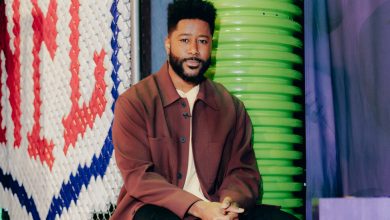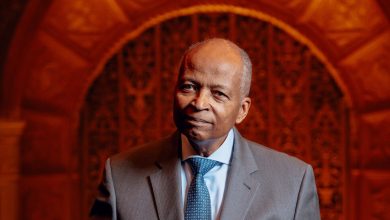She Wants to Heal the World Through Second Line

In most places, people either watch parades or march in them. In New Orleans, they have another option: second line.
As a noun, “second line” refers to those who follow a brass band through the streets — during Mardi Gras, or on any given Sunday, or on the way back from the cemetery in a jazz funeral, as dirges and hymns are replaced with joyful music for dancing. A second line isn’t official or planned. It grows, all ages rolling in with handkerchiefs and umbrellas, turning a parade into a peripatetic party.
As an adjective, “second line” can describe a characteristic beat, an Afro-Caribbean rhythm that runs through New Orleans music, from which it spread into the rest of the world’s jazz, R&B and funk.
“Second line” is also a verb. To second line is to dance. There aren’t set steps. Everybody does it a little differently. Most practitioners agree about one thing, though: It isn’t taught in a class.
“You fall into it” is how the choreographer and educator Michelle N. Gibson, who grew up in New Orleans, put it in a recent interview. “Nobody teaches second line.”
Except that Gibson does teach it, or her take on it. She teaches some of the history in her one-woman show, “Takin’ It to the Roots,” which she is bringing to the Jacob’s Pillow Dance Festival in the Berkshires, on Friday and Saturday. For the past few years, she has also been giving second line classes: workshops called New Orleans Original BuckShop in which she presents what she dubs her “second line aesthetic.”
Gibson, 47, has become a cultural ambassador for her hometown. “She’s able to tap into the collective ‘Come one, come all’ spirit of New Orleans, but also hold onto the spiritual tradition and the responsibility to ancestry,” said Melanie George, an associate curator at Jacob’s Pillow.
In Gibson’s workshops, she starts by helping students find the second line beat in their bodies, the bounce in their feet, hips, shoulders, heads. A strut shifts into a skip, because the dance has to cover ground. Gibson, who calls herself “sassy and saucy” and refers to herself as “Mz. G,” is an encouraging, permission-giving coach. Her most frequent and regular instruction: “Play with it.”
“‘Play with it’ means play with your own inner rhythm,” she explained in the interview. “That’s your real you. Everybody second line different, honey, because everybody got their own different testimonies.”
Her testimony is that of a preacher’s daughter. Her father, B.A. Gibson, was a presiding elder and minister in the African Methodist Episcopal Church. For much of her childhood, he was a pastor at St. Peter A.M.E. Church, one of the oldest Black congregations in uptown New Orleans.
Gibson’s father would not allow her to participate in second lines. “My daddy was not going to let me be jumping and shaking in those streets,” she said. (As a teenager, sometimes she would second line on the sly.) “But growing up in the church and watching people catch the spirit, Holy Ghost dancing — that was my second line.”
Not far from the church, she found another education, at the New Orleans Center for Creative Arts, where she specialized in dance. (Other center alumni include Jon Batiste, Harry Connick Jr. and the Marsalis brothers.) After graduating from high school, she spent a summer training at the Alvin Ailey school in New York, but when she booked a job touring with the hip-hop group Arrested Development, her mother disapproved and summoned her back home.
What came next was, in her words, “a struggle, a hustle.” A marriage quickly ended in divorce. While taking care of her infant daughter, she earned a B.F.A. in dance at Tulane University and performed with local dance companies of many kinds —Brazilian, West African, modern. “I was getting codified training,” she said, “but I was also going into the community and learning there.”
When Hurricane Katrina hit, in 2005, Gibson had just left the hospital after giving birth to a son. She evacuated with her children. Then she learned that her New Orleans apartment was unlivable. She moved to Dallas, where she still lives, now teaching at Southern Methodist University.
After a while, she pursued a master’s degree in dance and performance studies through the Hollins University-American Dance Festival graduate program at Duke University. Surrounded by successful midcareer dancers, she wondered what she had to contribute. She settled on her upbringing as a dancer in New Orleans. Especially after being displaced from her hometown, she wanted to dig deeper into its culture.
The result was the first incarnation of “Takin’ It to the Roots,” which she describes as a “spicy-ass gumbo” with a brass band, African drummers and dancers from the company of Chuck Davis, the founder of DanceAfrica. “I made sure I got it all in,” she said, showing second line’s roots (and by extension, her own) in Senegambia, Congo and Haiti.
That concern with history carries through to her one-woman version of the show, which she developed with the South Dallas Cultural Center and the Ashé Cultural Arts Center in New Orleans. And it comes through in her view of second line.
“When you see second line,” she said, “you’re seeing a history of Blackness, of who ended up at the Port of Orleans, of when we were allowed to celebrate.” She spoke about Congo Square — the New Orleans site where, in the early 19th century, enslaved people were allowed to drum and dance, a place where African traditions were braided and sustained. She spoke about the benevolent associations and the social aid and pleasure clubs that sponsored jazz funerals and second line parades. And she spoke about trauma, about Katrina, about those who had to leave, and those who stayed in a city that is still in turmoil.
“That’s what you’re seeing in the footwork and the thrust of the body,” she said. “You’re seeing their story.”
Gibson is careful to specify that what she teaches is her own second line aesthetic, “based on my training and how I want to share it,” not second line as New Orleans natives like herself experience it. “You can’t expect to have that,” she said. “You have to live it.” She said that she sees herself as an intermediary between her New Orleans community and academia, inserting herself into conversations about New Orleans culture and insisting on “reverence to the origins and the people it actually belongs to.”
For the Jacob’s Pillow performances, Gibson is converting “Takin’ It to the Roots,” originally designed for theaters, into processional form: Audience members will follow her to sites around the campus that represent Congo Square and the Black church. The second line at the performance’s end is standard, though. “I always take people out of the theater into the streets,” she said. “There’s not going to be a show that you attend with Mz. G that we’re not going to eventually go outside.”
There will of course be a brass band with her, the NOJO 7, drawn from the New Orleans Jazz Orchestra. Its artistic director, the drummer Adonis Rose, said he considers Gibson most distinctive as a teacher: “I’ve done pretty much everything you can do as a musician in New Orleans, and I’ve never seen anyone else come up with a curriculum on how to do the second line.” Her classes, he added, tie in to his own mission of “exporting our culture to people who wouldn’t be able to experience it otherwise.”
But Rose also emphasized the “spiritual experience” of following Gibson when she leads a brass band procession as grand marshal. This is another role she takes very seriously. Before accepting invitations to do it, she asked permission of the first female grand marshal she ever saw, Wanda Rouzan. “It’s a calling, an anointing,” Gibson said. “I grew up understanding that there is a Most High, and that is the grounds for me to strut like I strut.”
“This ain’t about dance for me anymore,” she continued, taking on the cadences of a preacher. “My practice is more motivated by spiritual unification, harmony, rolling on the same rhythms together and moving forward. That’s what the world needs. I want to heal the world. Just let me strut.”





